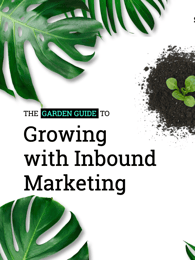
Marketing Trends According to INBOUND 2022: NFTs, AI, and Data
September 12, 2022
By Ale Melara
And we’re back in Boston! After two years of attending INBOUND through a virtual platform, we were finally able to get together in person. Our team attended both in person and virtually, so we got to consume way more content than expected—90 pages of team notes’ worth, to be exact!
We want to share all the knowledge and content we consumed, so we aren’t keeping those 90 pages to ourselves. Over the next week, we’ll be publishing a series of INBOUND 2022 recap blogs about:
- Business growth
- Marketing trends
- Social media
- Emotions, empowerment, and productivity in the workplace
- Creativity and culture in B2B marketing
Note: Powerhouse Pass attendees have access to the INBOUND 2022 virtual event platform for one year from today to rewatch any session on demand.
Here are my SmartBug® colleagues' highlights on four great INBOUND 2022 sessions.
What's Next: NFT Experiences for Consumer Brands
Presentation by:
Cameron Bale
NFT.Kred, Director, Marketing and Product Development
Michael Battaglia
NFT.Kred, Director, Customer Success
Dr. Quinn Button, Ph.D
NFT.Kred, VP, Growth
Watch the on-demand recording of the session (note that you must have an INBOUND 2022 Powerhouse Pass to view).
This session explored how brands are leveraging NFTs in their marketing strategies, why this new technology is poised to disrupt consumer engagement, and who is doing it right. You’ll leave this session understanding how you can elevate your own or your clients’ strategies with NFTs.
What are NFTs?
- NFTs are a medium for sharing digital content.
- Blockchain is a public ledger that verifies public transitions and now can verify true digital ownership. Once something is logged to the blockchain, it cannot be changed, deleted, or altered. It specifies where something came from, who created it, and who owns it.
- NFTs allow digital assets to be tradeable.
Why should NFTs matter to brands?
- People are becoming part of the NFT community and signaling that they are part of this community. Fans have become participants.
- NFTs allow for mutually beneficial relationships to be strengthened.
How have brands been using NFTs?
Coach
Coach, a designer brand, had a goal to engage with customers in a new way. This was their first time engaging with NFTs, and they wanted to make it as easy as possible for customers.
- Objective
- Social giveaway: A free NFT experience for the existing Coach community
- Real-world utility: Each NFT was redeemable for a custom Coach handbag
- Results
- Sold out in less than one minute
- Global press coverage
The first campaign was successful, so Coach launched a second campaign.
- Objective
- Reward loyalty: Coach Insider Members received early access to claim an NFT, with a goal to highlight the 1941 Heritage Collection.
- Results
- Sold out in minutes
- Increased Coach Insider sign-ups
PwC
PricewaterhouseCoopers (PwC) had a goal to provide their people with hands-on experience with NFTs.
- Objective
- Gamification: Rewarded attendees for participating in activities and demonstrations
- Education: Positioned PwC as a source of knowledge and expertise
- Results
- More than 50 C-Suite executives received their first NFT
- Attendees learned how to utilize NFTs in their own businesses
SAP Software Solutions
SAP’s overall objective was to share a company-wide achievement with employees.
- Objective
- Award NFT and provide a verifiable Credential
- Set up an email workflow through HubSpot where recipients could receive their NFTs
- Results
- 2,000 employees claimed and now share the award
- Many of them feature the award as a verified credential on LinkedIn
What are the 5 ingredients for a successful brand NFT project?
- Authenticity: Create an on-brand experience. What makes sense for your business?
- Accessibility: Meet fans where they are with simple onboarding. This could include signing up with an email or phone number, or connecting via Twitter.
- Familiarity: Let fans pay in the way they are used to paying.
- Sustainability: Eco-friendly solutions mean not having to compromise your commitment to the environment. Instead of physical swag that usually gets thrown away, use a digital NFT that invites in people who want to participate.
- Connectivity: Bring the data back home via the HubSpot Contact Timeline. Understand information such as:
- Who claimed and redeemed the NFT
- How to re-engage with those who haven’t redeemed their NFT
How AI Will Transform the Way Marketers Work
Presentation by:
Dale Bertrand
Fire&Spark, President
Watch the on-demand recording of the session (note that you must have an INBOUND 2022 Powerhouse Pass to view).
Artificial intelligence (AI) expert Dale Bertrand shares an optimistic take on how to leverage unique human traits in an AI marketing world.
When we think about AI, we immediately think about automation. But modern AI has the potential to change the way marketing works in a much deeper way than just automation. What if software could automate and personalize our email sends?
This technology is already here today—we have deep learning algorithms that can spot patterns, for example—but we aren’t using it. It’s going to take a while for software companies to incorporate this technology, and it’s going to take some time for marketers to learn new workflows, understanding what’s possible and how to work with them.
To get value out of these tools, can software emulate human creativity? In many ways, it can and it definitely will. Designs.ai is an example of AI: No humans are required, and it can create a logo in five minutes. This is an example of technological progress that can change the way we work.
The Future of Customer Privacy with Google
Presentation by:
Parish Aggarwal
Head of Ads Measurement and Privacy, Google
Watch the on-demand recording of the session (note that you must have an INBOUND 2022 Powerhouse Pass to view).
Google Consumer Solutions’ head of measurement and privacy shares how the marketing ecosystem is experiencing a paradigm shift and explains how we can prepare as marketers for what’s coming next.
The digital space is experiencing a paradigm shift.
Customers are sensitive to privacy and expectations are higher. Customers want more, and it matters to people more than ever. At the same time, two-thirds of people do not trust companies with their data. But not all is lost—privacy can be done right. For instance, 90 percent of Gen Z and millennials are willing to share personal information in exchange for personalized experiences.
What regulations must be accounted for?
Third-party tracking restrictions can cause data gaps. As a result, three business critical areas will be impacted:
- Measurements
- Audience lists
- Audience bidding
Downstream bidding will be affected because of the loss of upstream data.
What are the opportunities?
When mobile came along, it was initially dismissed. But we took a long time to invest in mobile technology—and then came a decade of growth!
Google is investing in:
- First-party data and infrastructure
- Modeling, machine learning, and automation
- Privacy preserving
Why first-party data matters.
If privacy is queen, then first-party data is king (and will be for the next decade!). Using first-party data might seem obvious, but only 30 percent of companies are collecting and integrating it, and only 1 percent are using data to deliver fully cross-channel experiences.
The opportunity is there, if you invest in first-party data. It can be intimidating, but Google Tag Manager is making this easier.
How can we measure data more accurately?
The measurement landscape is changing. Use the following tactics to measure more accurately:
- Enhanced conversions for web: Helps in a cookie-less world
- Consent Mode: Seventy-six percent of users ignore consent banners today! Consent mode solves for this by adjusting the back-end tag behavior. Conversion modeling fills data gaps when banners are ignored. This respects user choices while still letting you measure what you need to.
- What to expect in the future and long term: Modeling and machine learning is the only way to fill data gaps; they will become extremely important in the long term.
Why prepare now?
What’s Next Stage: The Future of Growth Is About Connections
Presentation by:
Rob Giglio
HubSpot, Chief Customer Officer
Emilie Wells
Triago, CMO
Watch the on-demand recording of the session (note that you must have an INBOUND 2022 Powerhouse Pass to view).
Rob and Emily explore HubSpot’s vision of the age of the connected customer and discuss how the right CRM can be the key to unlocking an interconnected environment with data at its core to engage, inspire, and build better relationships with customers.
How can we solve the disconnection crisis?
It’s possible to connect customers, systems, and communities. Systems have to be able to connect with each other seamlessly. People must connect with those systems and with their audiences. Don’t lose the personal touch! Remember to create relationships with leads and make leads feel connected.
Use the 3x5 method.
Expect three touches per day for five days from the sales team.
- Understand the importance of SalesHub to automate the process when needed, and save personal conversations for the phone calls.
- Maximize efficiency with automation without losing the connection between the prospect and our sales team.
Consider the following marketing tips.
- Think about how you can give your best with communication.
- Continue to refine. Ask, “How can we make this even better?”
- Move to the “problem-solving” role.
- Always connect to the biggest business picture, not just the small metrics such as CTRs, open rates, and so on. Show what impacts the bottom line.
- Leverage connectedness. Use HubSpot for systems/support across your tech stack.
Stay tuned for more INBOUND 2022 recaps on the SmartBug Blog, coming up this week!

About the author
Ale Melara is a Sr. Content Marketing Manager based out of El Salvador, Central America. Ale is our very first LATAM employee. She's worked remotely for the past 5 years and she's had different roles in sales and marketing. In her free time, she works on creating educational videos around digital marketing for her "Inbound Nomad" social accounts where she promotes traveling the world while being a full-time marketer. Read more articles by Ale Melara.








